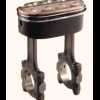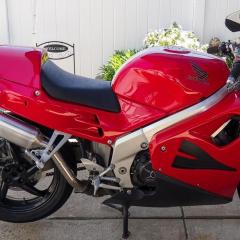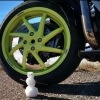Leaderboard
Popular Content
Showing content with the highest reputation on 02/23/2024 in all areas
-
A tiny big update. I wanted to do this for a long time but there is not alot of options for keeping this priced within my budget - untill I realized this was something you could buy as bolt on mod for ducatis. So one week later my panigale bolt on cover arrived and it turned out perfect. I wanted make this as low profile as possible so I had to move the filler neck inwards. The ring is welded on the outside and the neck from the inside. This makes me able to inspect the clutch and watch it rotate with ease! You see it's kind of a hassle to remove the clutch cover as the supercharger pulley is glued, the belt needs tensioning and of course the right fairing needs to come of. Now it's a 10 minute job to change the clutch. If someone know how to remove the text on the anodized ring id like to know how without having to re-anodize the whole ring. It's not engraved and it's on top of the anodozing.2 points
-
You keep saying "banjo". Do you really mean that? Cuz that hole (and internal fitting style) doesn't take a banjo bolt and crush washer(s).1 point
-
For those interested, Formula one teams did a lot of experimentation with velocity stacks in the 60ties. It was called air resonance charging if I remember correctly. The idea behind was that the air in a long stack with certain conical profile and diameter to length relation could be accelerated in the intake by resonance. There were even books in the engineering section of my school about it. I played with this many moons ago on my first underpowered car and limited funds. These were cool times1 point
-
Below is the fix my buddy did. The track is very small so using the copper foil wasn't going to work. I plugged it into the bike and all of the backlight LEDs come on now. I put some RTD silicone (all I had on hand) in that spot to cover the now-exposed connection and to keep further moisture from gathering there. I did think of using desiccant and gluing a bag inside so it doesn't move around and cause problems. Then again, the only reason I had this issue was cause the bike was outside one winter with fluctuating temps and humidity. I will put something on the rubber boot that covers the console connector, the console itself doesn't have a gasket but it has a pretty long knife edge all around. As for the tach, I figured as much, so I wasn't about to dig that deep and desolder it. I'm sure there is a way to get the dial off unless they put the whole assembly together and then soldered it to the card.1 point
-
Understanding how an air box works and the reasons why a stock box is a safer bet... If you have ever had the gas tank off your late-model sportbike, you will notice that the front of the fuel tank doesn’t hold fuel; it holds an airbox. In the old days, when you bought a new bike, it had an air-filter case attached to feed the carburetors or the fuel-injection intakes. All the sharp, young guys would immediately rip off the filter case and replace it with four sock filters. Reduced airflow resistance. Much better performance. One day in the late 1980s, they began to rip off the airboxes of their new bikes and their engines fell on their faces. They lost a bunch of performance. “This can’t be happening! Putting on sock filters always worked before.” But it turns out the industry found a way to boost performance by making what is known as a resonant airbox. We have all in an idle moment blown across the mouth of a beer bottle and heard the "whoooo" of the bottle resonance. As air goes across the mouth of the bottle, it creates a low pressure, which causes air to flow up. That deflects the air away from the mouth of the bottle. Then the air goes back in, the airflow from your mouth goes back across, and the cycle repeats, rapidly fluttering and producing that deep tone. The compressible air in the bottle is acting as a spring, and the slug of air in the neck of the bottle is the mass that vibrates against that spring. This intake airbox from a fuel injected Honda is just a glorified beer bottle. Instead of the engine blowing across the mouth of it, its four throttle bodies are sucking from the box, pulling its pressure down. Air rushes in through the ducts in the fairing to fill up that low pressure. The next cylinder sucks the bottle pressure down and more air rushes in and restores the pressure. If the volume of the box and the mass of the air in the intake pipes are correctly chosen, the box will hum like the beer bottle. The trick is to get your engine to draw air from the box when the pressure is up and then the box refills when the pressure is down. And that is why ripping the airboxes off and putting on old-time sock filters resulted in a reduction in performance. In a specific zone of rpm, a resonant airbox can boost your engine’s torque by 10 percent. That’s worth having! My friend Stephen called long distance from England because he just installed a $900.00 HRC air box on his RC45 and saw 120HP on the dyno... mmmmm... together we wondered if the stock box be modified??? We found that stock RC45 throttle bodies are 46mm but the air box was restricted to 40mm... no problem... I'll bore the air box out to 47mm on the milling machine... I drew up plans for 47mm bell mouth based on the stock 40mm bell mouths and purchased a block of black Delrin... I'm not happy doing repetitious work but I labored long hours to machine 4 each bell mouths with my best accuracy... Don't you love when a plan comes together especially if it turns out perfect??? Now I had an unrestricted air box with my own 47mm bell mouths... it was the best I could do to replicate HRC $900.00 air box... not to mention I wanted to keep my home made K&N filter... Time to put the Mod to the test on the dyno... this is Dave at Chandelle Motorsports... No joy... I lost 1.8HP on the dyno... so bigger is not better in this case... a whole week worth of work shot down in flames... it seems Honda got the intake velocity right for a stock pipe after all... air boxes are like tuned instruments... alter the holes and the tune just makes sour notes and power suffers... Mr.RC45 fueling is not the problem... my air box will remain stock because our air box works like a finely tuned instrument... any wild ass guess mod disrupts this highly engineered resonant to where to you're producing nothing but sour notes... The airbox inlet tubes, or “horns”, are specifically designed to provide a resonance that can increase the total airflow by up to 10-15%. Second guessing these can cause the engine to loose power and increase the intake noise as in my case... RC45's stock intake horns are there for homologation purposes only and do not directly feed into the airbox only the HRC intakes feed ram air into the airbox...1 point
-
I bought from this place: https://www.ebay.com/itm/201413374648 Seems to work fine, lots of options on eBay too.1 point
-
Here you shall find Brian, always up for some NorCal mayhem. In for March 2.1 point
-
1 point
-
Yes! As you might have guessed, im re-starting this adventure again. Updates will now follow semi-regurlaly again. Im sorry for the silence, but i seem to loose more and more of my free time as age progresses. Cheers to those who have helped keeping this forum alive and to the man himself! I was sure i had to start a new thread on vfrworld...1 point
-
No dipstick, I added a clear tube to indicate oil level I bought a complete used A&A kit, one of the original 6g kits. I made the oil cooler from a 6g radiator. New larger SH847 rr is mounted on the left side of the frame now. I didn't get a chance to make a thread for my rebuild before leaving on a trip, but I plan to make a list of mods with pics when I return.1 point




























